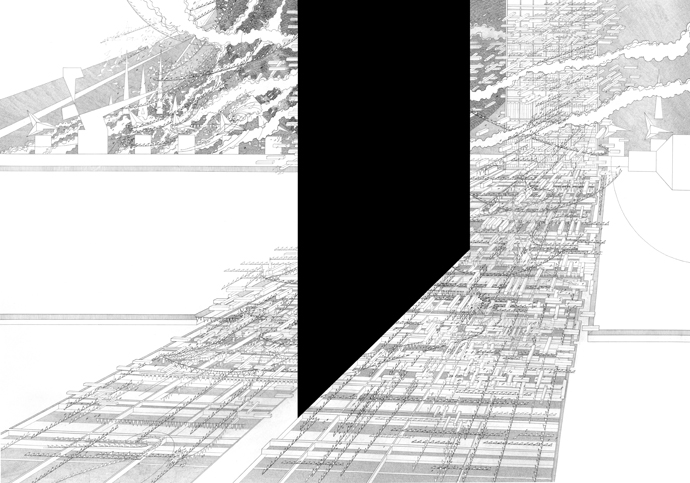from pastelegram.org, June 2011 – April 2014
Seher Shah: Constructed Landscapes
In the gallery lobby of Seher Shah's exhibition Constructed Landscapes is Object Repetition (Line to Distance) from 2013, a collection of a thousand or so six to eight-inch tall plaster trapezoidal solids arranged on the floor. One corner of each solid extends sharply upwards, allowing the collection of solids to divide into groups that face similar directions, like soldiers. Many groups of varying numbers and directional preferences intersect turbulently with each other, a sort of geometric ocean eddy. In these moments of flux the individual trapezoidal solids lose connection with their armies and spin off into new territories and outcast groups. Whole groups of solids have fallen over and many have acquired new markings. Because the work is small and spread out on the floor, the viewer sees the whole scene from above. The entire arrangement of objects is still, but through the use of shape and composition the work acts as a diagram of some unknown event or movement, like a technical illustration reproduced outside of its context.

Shah's series of images, Mammoth: Aerial Landscape Proposals, (2012), also works with birds-eye perspective. The work is a series of twenty-one framed images arranged in a three by seven grid on the wall. Taken from not-quite-directly above, the photographs feature various altered landscapes from sprawling urban development to agriculture to large-scale industrial landscapes such as oil fields. The slight perspective on each image conflicts with the artificial grids and land use patterns, distorting the sense of space as the eye quickly flips between reading flatness to reading great depth. In half of the photographs Shah digitally collages new geometric shapes onto the images, further flattening the affected compositions. Shah’s introduced shapes are interesting. Generally rectilinear and angled solids, each remains unique from the others. All are either solid black, solid white, semi-opaque black or semi-opaque white. Often Shah overlays the shapes onto the photographs without reference to the underlying photographic perspective, but occasionally the shape's angles and edges align deliberately to the landscape geometries below. At times they work to obscure, in the way that the military might redact a document's sensitive truths with deliberate blackouts. When the shapes are translucent they instead act like a map of potential re-development, highlighting the areas of the built environment proposed for clearance and renewal. The shapes transform these aerial photographs into obscure diagrams whose concept is left unexplained.
Architect Bernard Tschumi explains this as “designing without designing.”1 Through an exploration of graphic methods and notational systems, a designer can offer a hypothetical diagram of an architectural condition without needing to explain the nature of that condition. Instead of diagramming an architectural concept, Tschumi uses drawing itself as the conceptual generator. When the designer reverses their understanding of the diagram from concept-driven to concept-producing, they can push the boundaries of drawing. Instead of, “What is this building’s diagram?,” one can ask, “What kind of building could have this diagram?”

Seher Shah, Object Relic (Unite d’Habitation), 2011; graphite and goauche on paper; private collection in Hong Kong.
Architecture professor Igor Siddiqui relates Seher Shah's work to Tschumi's foundational Manhattan Transcripts (1976-81) in the catalog essay for Shah's show, and this formal comparison is clearest with Shah's Object Relic (Unite D'Habitacion) (2011). A large drawing, several feet in both directions, Object Relic depicts a large, scaleless and gridded superstructure in a distorted birds-eye perspective. The structure contains hundreds of rectilinear boxes, like shipping containers, organized within the grid. Swirling around this rigid system are diagrammatic dashed lines depicting the fluid motion of unknown flying objects. These lines start mysteriously and end in large explosions with the boxes. Covering a significant portion of the drawing, undeterred by the events beneath, is a large, solid black and trapezoidal shape in gouache, not unlike what appears in Mammoth. Like Object Repetition, a frozen geometric drama unfolds from a god-like viewpoint; but like Mammoth, Shah ambiguously superimposes a new formal order that both flattens the perspective and conceals the actions occurring within the drawing.
Shah explores the language of the architectural diagram with her use of geometry, perspective and line but she treats the diagram as the generator of a to-be-determined design proposal. Like the work of Tschumi and his contemporaries, the power of these kinds of drawings lie in their ability to perpetually and autonomously exist in a state of becoming.
Seher Shah's show is on view through June 30th.
- 1. See Tschumi's recent lecture “Red is Not a Color,” presented along with with his retrospective publication of the same name, March, 28, 2013, at the Harvard University Graduate School of Design, http://www.youtube.com/watch?v=nJ4RIYkJ_v0